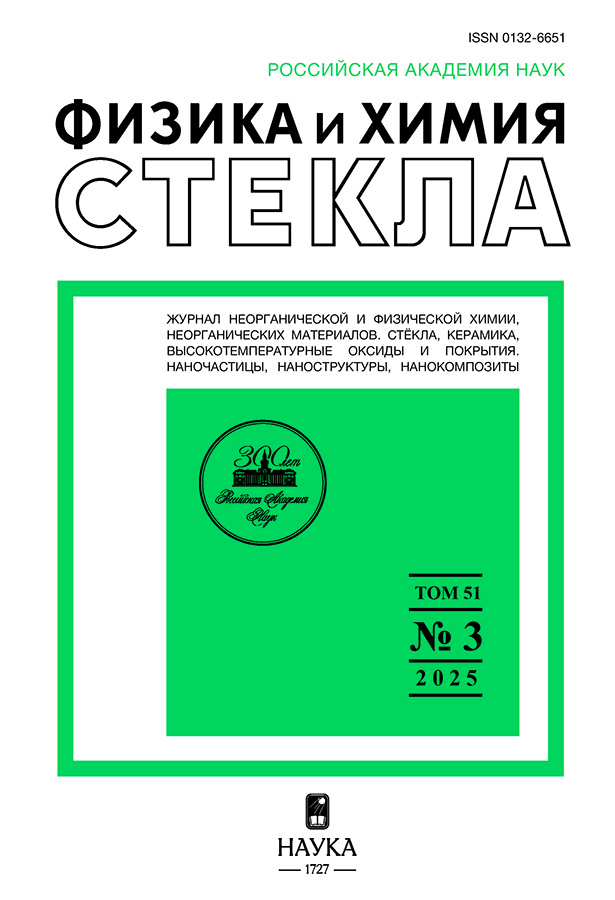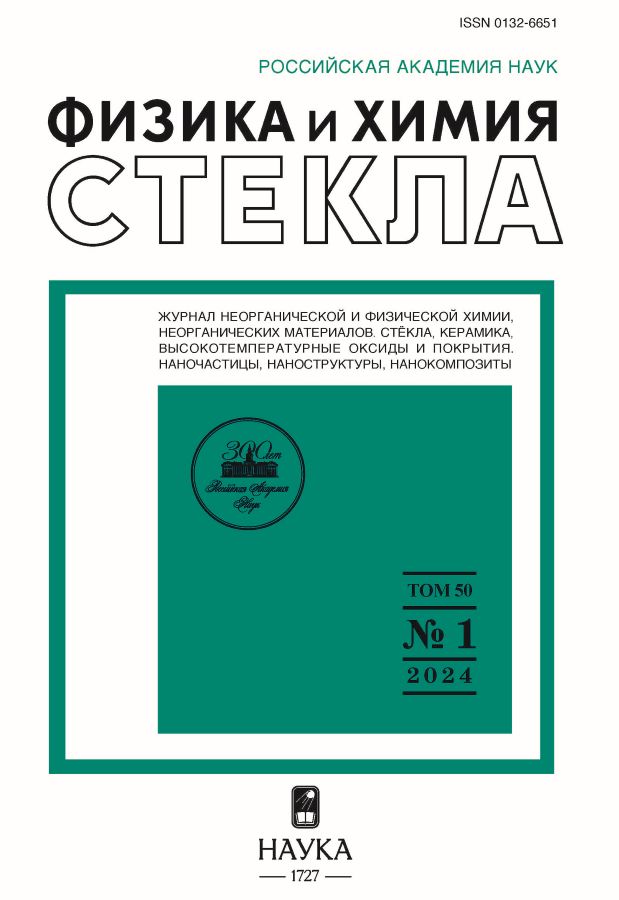Зависимость микротвердости стекол от температуры
- Авторы: Тверьянович Ю.С.1
-
Учреждения:
- Институт химии Санкт-Петербургского государственного университета
- Выпуск: Том 50, № 1 (2024)
- Страницы: 43-54
- Раздел: Статьи
- URL: https://rjonco.com/0132-6651/article/view/663231
- DOI: https://doi.org/10.31857/S0132665124010058
- EDN: https://elibrary.ru/SIINZJ
- ID: 663231
Цитировать
Полный текст
Аннотация
Предложен метод расчета температурной зависимости микротвердости стекол в интервале температур от абсолютного нуля до температуры размягчения. Согласно модели, положенной в основу расчета, стекло переходит в пластическое состояние не только под действием температуры, но и под действием механических напряжений выше критической величины, соответствующей микротвердости. Поэтому при одновременном воздействии этих двух факторов стекло переходит в пластическое состояние в том случае, если сумма термической и механической энергии сетки стекла превышает критическую величину. Предложенный метод расчета опробован на примере органического стекла и двух наиболее важных для практики оксидных стекол: плавленого кварца и промышленного щелочно-силикатного стекла (soda lime silica glass).
Ключевые слова
Полный текст
Об авторах
Юрий Станиславович Тверьянович
Институт химии Санкт-Петербургского государственного университета
Автор, ответственный за переписку.
Email: y.tveryanovich@spbu.ru
ORCID iD: 0000-0003-4343-9817
Россия, 198504, Санкт-Петербург, Университетский пр., 26
Список литературы
- Cook R.F., Pharr G.M. Direct Observation and Analysis of Indentation Cracking in Glasses and Ceramics // J. Am. Ceram. Soc. 1990. V. 73. № 4. P. 787–817.
- Guin J.-P., Rouxel T., Sangleboeuf J.-C. Hardness, Toughness, and Scratchability of Germanium-Selenium Chalcogenide Glasses // J. Am. Ceram. Soc. 2002. V. 85. № 6. P. 1545–1552.
- El-Zaidia M.M., El-Gohary Z.H., Abo-Ghazala M.S., Turky G.M., Rabea E.A. Mechanical Properties of Chalcogenide Optic Fiber Material Based Tellurium // IOSR Journal of Applied Physics. 2019. V. 11. № 1. P. 55–61.
- Rouxel T. Elastic Properties and Short-to Medium-Range Order in Glasses // J. Am. Ceram. Soc. 2007. V. 90. № 10. P. 3019–3039.
- Freitas J., Shimakawa K., Kugler S. Some remarks on the glass-transition temperature in chalcogenide glasses: a correlation with the microhardness ruben // Chalcogenide Letters. 2013. V. 10. № 1. P. 39–43.
- Kugler S., Shimakawa K. Amorphous Semiconductors. Cambridge University Press. 2015. P. 147.
- Balta-Calleja F.J., Sanditov D.S., Privalko V.P. Review: the microhardness of non-crystalline materials // J. Mater. Sci. 2002. V. 37. № 21. P. 4507–4516.
- Fakirov S. The Relationship Between the Microhardness and Glass Transition Temperature of Inorganic Glasses Compared with Polymeric Glasses // Int. J. Polymeric Mat. and Polymeric Biomaterials. 2005. V. 54. № 12. P. 1185–1189.
- Fakirov S., Balta-Calleja F.J., Krumova M. On the Relationship between Microhardness and Glass Transition Temperature of Some Amorphous Polymers // J. Polymer Science: Part B: Polymer Physics. 1999. V. 37. № 13. P. 1413–1419.
- Slouf M., Strachota B., Strachota A., Gajdosova V., Bertschova V., Nohava J. Macro-, Micro- and Nanomechanical Characterization of Crosslinked Polymers with Very Broad Range of Mechanical Properties // Polymers. 2020. V. 12. № 2951. 26 p.
- Tveryanovich Yu.S. On the Correlation of the Microhardness and Softening Temperature for Chalcogenide Glasses // Glass Physics and Chemistry. 2022. Vol. 48. No. 1. P. 72–74.
- Tveryanovich Yu.S. The Relationship between Microhardness and Glass Transition Temperature of Chalcogenide Glasses // Glass Physics and Chemistry. 2022. Vol. 48. № 4. Р. 243–247.
- Mitkova M., Wang Yu., Boolchand P. Dual Chemical Role of Ag as an Additive in Chalcogenide Glasses // Physical Review Letters. 1999. V. 83. № 19. Р. 3848–3851.
- Varshneya A.K. Fundamentals of inorganic glasses. San Diego. Academic Press. 1994. P. 187.
- Shelby J.E. Introduction to glass science and technology. Cambridge, UK. The Royal Society of Chemistry. 1997. 188 р.
- Wiederhorn S.M., Hockey B.J. Hot erosion of glass // J. of Non-Cryst. Sol. 1980. V. 38–39. № 1. P. 433–438.
- Watanabe T., Muratsubaki K., Benino Y., Saitoh H., Komatsu T. Hardness and elastic properties of Bi2O3-based glasses // J. of Materials Science. 2001. V. 36. P. 2427–2433.
- Watanabe T., Benino Y., Ishizaki K., Komatsu T. Temperature Dependence of Vickers Hardness for TeO2-Based and Soda-Lime Silicate Glasses // Journal of the Ceramic Society of Japan. 1999. V. 107. № 12. P. 1140–1145.
- Fomenko L.S., Lubenets S.V., Natsik V.D., Prokhvatilov A.I., Galtsov N.N., Li Q.Q., Koutsos V. Investigation of the low-temperature mechanical behavior of elastomers and their carbon nanotube composites using microindentation // Fiz. Nizk. Temp. 2019. V. 45. P. 663–672.
- Beake B.D., Smith J. F. High-temperature nanoindentation testing of fused silica and other materials // Phil. Mag. A. 2002. V. 82. № 10. P. 2179–2186.
- Fakirov S., Krumova M., Krasteva B. On the temperature dependence of microhardness of some glassy polymers // J. of Materials Science Letters. 2000. V. 19. P. 2123–2125.
- Rusakova H.V., Fomenko L.S., Lubenets S.V., Natsik V.D. Low-Temperature Features of the Micromechanical Properties of Polystyrene // Fiz. Nizk. Temp. 2019. V. 45. P. 1538–1548.
- Kasap S.O., Yannacopoulos S. Mechanical and thermal properties of the glassy semiconductor chlorinated Se0.997As0.003 used as an X-ray imaging material // Can. J. Phys. 1989. V. 67. P. 686–693.
- Keryvin V., Korimilli P.E., Gueguen Y., Sangleboeuf J.-C., Ramamurty U. Temperature dependence of mechanical properties and pressure sensitivity in metallic glasses below glass transition // Philosophical Magazine. 2008. V. 88. № 12. P. 1773–1790.
- Vaillant M.L., Keryvin V., Rouxel T., Kawamura Y. // Scripta Mater. 2002. V. 47. № 1. P. 19.
- Keryvin V., Bernard C., Sanglebœuf J.-C., Yokoyama Y., Rouxe T. Toughness of Zr55Cu30Al10Ni5 bulk metallic glass for two oxygen levels // J. Non-Cryst. Sol. 2006. V. 352. № 26–27. P. 2863.
- Peker A., Johnson W.L. A Highly Processable Metallic Glass: Zr41.2Ti13.8Cu12.5Ni10.0Be22.5 // Appl. Phys. Letters. 1993. V. 63. P. 2342–2344.
- Donovan P. Plastic flow and fracture of Pd40Ni40P20 metallic glass under an indentor // J. Mater. Sci. 1989. V. 24. P. 523–535.
- Le Bourhis E., Gadaud P., Guin J.-P., Tournerie N., Zhang X.H., Lucas J., Rouxel T. Temperature dependence of the mechanical behavior of a GeAsSe glass // Scripta Materialie. 2001. V. 45. P. 317–323.
- Calleja F.J.B., Sanditov D.S., Privalko V.P. Review: the microhardness of non-crystalline materials // Journal of Materials Science. 2002. V. 37. P. 4507–4516.
- Shunbo W., Tver’yanovich Yu.S. Relationship of Temperature Dependences of Microhardness and Enthalpy of Glass on the Example of Selenium // Glass Physics and Chemistry. 2023. V. 49. № 4. P. 336–339.
- Andrievskii R.A., Lanin A.G., Rymashevskii G.A. Prochnost’ tugoplavkikh soedinenii (Strength of Refractory Compounds). Moscow: Metallurgiya, 1974. 232 р.
- Fischer-Cripps A. C. Introduction to Contact Mechanics. Second Edition. New York. Springer, 2007. 221 р.
- Gere J.M., Timoshenko S.P. Mechanics of Materials. GB: Stanley Thornes, 1999. 913 p.
- Chung H.-Y., Weinberger M.B., Yang J.-M., Tolbert S.H., Kaner R.B. Correlation between hardness and elastic moduli of the ultraincompressible transition metal diborides RuB2, OsB2, and ReB2 // Appl. Phys. Letters. 2008. V. 92. № 261904.
- Rouxel T. What we can learn from crystals about the mechanical properties of glass // J. of the Ceramic Society of Japan. 2022. V. 130. № 8. P. 519–530.
- Yamane M., Mackenzie J.D. Vicker’s Hardness of glass // J. of Non-Cryst. Sol. 1974. V. 15. № 2. P. 153–164.
- Ali S. Properties and Hardness of Mixed Alkaline Earth Silicate Oxynitride Glasses // Materials. 2022. V. 15. Р. 5022.
- Marti E., Kaisersberger E., Moukhina E. Heat capacity functions of polystyrene in glassy and in liquid amorphous state and glass transition DSC and TMDSC study // J. of Thermal Analysis and Calorimetry. 2006. V. 85. № 2. P. 505–525.
- Katare R., Bajpai R., Datt S.C. Microhardness of Blends of Polystyrene and Polymethyl methacrylate // Polymer Testing. 1991. V. 10. P. 139–143.
- https://designerdata.nl/materials/plastics/thermo-plastics/polystyrene
- https://polymerdatabase.com/polymers/polystyrene.html
- https://srd.nist.gov/JPCRD/jpcrd202.pdf; https://pubs.usgs.gov/of/1994/0671/report.pdf
- Fanderlik I. 4 — Physical and Chemical Properties of Silica Glasses // Glass Science and Technology. 1991. V. 11. P. 194–270.
- Sharp D.E., Ginther L.B. Effect of Composition and Temperature on the Specific Heat of Glass // J. of the Amer. Ceramic Society. 1951. V. 34. № 9. P. 260–271.
- Beake B.D., Smith J.F. High-temperature nanoindentation testing of fused silica and other materials // Phil. Mag. A. 2002. V. 82. № 10. P. 2179–2186.
- Huang J., Gupta P.K. Temperature dependence of the isostructural heat capacity of a soda lime silicate glass // J. of Non-Cryst. Sol. 1992. V. 139. P. 239–247.
- Cachiaras A., Gilde L., Swab J.J., Patel P.J., Quinn G.D. Soda-Lime-Silicate Float Glass: A Property Comparison. US Army Research Laboratory. 2017. TR-8187.
- Watanabe T., Benino Y., Ishizaki K., Komatsu T. Temperature Dependence of Vickers Hardness for TeO2-Based and Soda-Lime Silicate Glasses // J. of the Ceramic Society of Japan. 1999. V. 107. № 1252. P. 1140–1145.
- Wilantewicz T.E., Varner J.R. Vickers indentation behavior of several commercial glasses at high temperatures // J. Mater. Sci. 2008. V. 43. P. 281–298.
Дополнительные файлы















